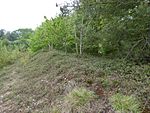St Cross South Elmham

St Cross South Elmham is a village and civil parish in the north of the English county of Suffolk. It is in the East Suffolk district, close to the border with Norfolk and is 3 miles (4.8 km) east of Harleston and 4.25 miles (6.84 km) south-west of Bungay. It is one of the villages around Bungay known as the Saints. The parish has a population of around 120. The parish borders the parishes of St Margaret South Elmham, Homersfield, Flixton, All Saints and St Nicholas South Elmham, St James South Elmham, Metfield and Mendham. The parish council is joined with Flixton and St Margaret South Elmham.The parish name is a portmanteau of the medieval parish name "Saint George Sancroft", as the village church is named St George. The Sancroft part of the name comes from the sandy nature of the soil in the area surrounding the church of St George. The modern village itself is small and lacks services beyond the parish church. A volunteer group known as Waveney Community Bus, provide a bus service to residents living in the St Cross area.St Cross is known for its views of the English countryside and was home to the poet and writer Elizabeth Smart for the last years of her life. She was buried in the graveyard of the church of St George after her death in 1986.
Excerpt from the Wikipedia article St Cross South Elmham (License: CC BY-SA 3.0, Authors, Images).St Cross South Elmham
East Suffolk
Geographical coordinates (GPS) Address Nearby Places Show on map
Geographical coordinates (GPS)
| Latitude | Longitude |
|---|---|
| N 52.406 ° | E 1.38 ° |
Address
IP20 0PH East Suffolk
England, United Kingdom
Open on Google Maps










